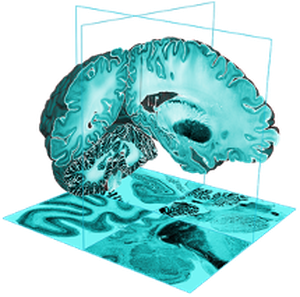HIBALL
Helmholtz International BigBrain Analytics and Learning Laboratory

Project description

Neuroimaging methods rely on accurate brain models as ground truth to develop reliable approaches for probing the brain. Researchers in brain simulation and AI have a growing need for detailed descriptions of the internal organisation of brain regions in terms of local morphology, cell densities, or connectivity. A basis for this has been provided with the advent of the BigBrain- a human post-mortem brain that has been sectioned, stained for cell bodies, scanned at very high resolution, and then digitally reconstructed in 3D (Amunts, Evans et al. 2013). HIBALL aims to extend this model by further increasing its resolution and integrating multimodal data, working closely with the neuroimaging, brain modelling, and AI communities to unleash its potential for research.
Objectives
By developing novel AI-based methods for analyzing high-resolution image data, HIBALL aims at new highly detailed maps of brain areas, cortical layers, and subcortical structures for microscopic brain models. Thereby it will complement the cytoarchitectonic model by modalities that cover fibre- and chemoarchitecture and will work towards a multimodal characterization of the human brain at the microscopic scale. Furthermore, HIBALL targets towards a model with a resolution in 1 micron range, which resolves individual neuronal cell bodies.
Reaching data size at the Petabyte scale HIBALL addresses Big Data challenges with specific workflows for distributed data management and processing, and tools for remote visualization and annotation of 2D and 3D data.
These infrastructure development efforts will be aligned with the developments of the Human Brain Project and the Canadian Healthy Brains for Healthy Lives (HBHL) program to maximize compatibility with the international initiatives.
HIBALL aims to create strong links between AI, data science, and brain inspired computing. The project develops novel image analysis methods based on Machine and Deep Learning, and contributes knowledge about the microstructural organization of biological neural networks in the brain. The project initiates early cooperation with researchers in brain inspired AI and computing to incorporate information about the human brain into the design of artificial systems.
The VirtualBrain (TVB), another integral HBP partner, uses empirical knowledge of brain structure to constrain models that simulate network dynamics, which in turn can be validated with experimental observations of brain function. Complementing related work in the Human Brain Project, HIBALL supports the development of TVB models with increased spatial resolution and regional heterogeneity by informing them with microscopic resolution data, and evaluating optimized software and hardware environments for the CBRAIN platform.
Finally, HIBALL and the BigBrain Project continue to build an open resource and a lively scientific community within a collaborative research and training environment. We will share our datasets and tools through the platform, aim to integrate them with the EBRAINS and CBRAIN ecosystems, and engage with the BigBrain user and contributor community through open project meetings, workshops, and online services.
Collaboration with HBP
HIBALL will in a multitude of ways contribute to the HBP objective to create and operate EBRAINS as a European scientific research infrastructure for brain research, cognitive neuroscience, and other brain-inspired sciences, as well as to gather, organise and disseminate data describing the brain and its diseases.
To enable collaboration, HIBALL will build a transcontinental data sharing and computing platform in close interaction with HBP and the Canadian HBHL program.
HIBALL will spend significant effort on the integration of brain mapping projects in the international community related to the BigBrain, and provide these data for integration and dissemination via the EBRAINS data sharing and atlas services. It will help develop simulation tools, by integrating microstructural information into the models, that can be provided and used in the HBP. It will also develop novel multimodal extensions to the BigBrain, in particular well integrated 3D models of structural connectivity and chemoarchitecture, not least through the development of novel Deep Learning methods that employ the latest HPC architectures to analyze Petabyte-scale neuroscience data. HIBALL will therefore be a multiplier for integration of external data to the EBRAINS human brain atlases.
HIBALL will incorporate BigBrain cortical layer, chemoarchitectural information, and neural mass models into an expanded TVB: The Virtual BigBrain (TVBB), directly complementing efforts in HBP. Gene expression maps from the Allen Institute will also be mapped to BigBrain, complementing ongoing integration of JuGEx into the HBP online atlas services for differential gene expression analysis.
In addition to adopting reusable software components of EBRAINS, HIBALL also aims to contribute software extensions to EBRAINS. For example, a coordinated effort to improve rendering of surface meshes in NeHuBa is anticipated, which will be integrated back into EBRAINS services.
HIBALL will evaluate the benefits of code parallelization and GPU utilization for application in the Canadian CBRAIN platform, that allows neuroimaging researchers to perform computationally intensive analyses on High-Performance Computing (HPC) facilities across Canada and around the world, while HBP is working on extensions to the NEST simulator platform.
Partnering Organisations

Project Coordinators

Director of McGill Centre for Integrative Neuroscience (MCIN)
Co-Director of the Ludmer Centre for Neuroinformatics and Mental Health
Scientific Director of McGill’s Healthy Brains for Healthy Lives (HBHL) initiative
Scientific Director of the Canadian Open Neuroscience Platform

Director of the Institute Structural and functional organisation of the brain (INM-1) at Forschungszentrum Jülich, Germany
Director of the C. and O. Vogt-Institute of Brain Research, Universitätsklinikum Düsseldorf
Scientific Research Director and Chair of the Science and Infrastructure Board (SIB) of the HBP
Publications
Amunts K, Lepage C, Borgeat L, Mohlberg H, Dickscheid T, Rousseau ME, Bludau S, Bazin PL, Lewis LB, Oros-Peusquens AM, Shah NJ, Lippert T, Zilles K, Evans AC (2013) BigBrain: An ultrahigh-resolution 3D human brain model. Science, 340(6139): 1472-1475. link
Amunts K, Hawrylycz M, Van Essen D, Van Horn JD, Harel N, Poline JB, De Martino F, Bjaalie JG, Dehaene-Lambertz G, Dehaene S, Valdes-Sosa P, Thirion B, Zilles K, Hill SL, Abrams MB, Tass PA, Vanduffel W, Evans AC, Eickhoff SB (2014) Interoperable atlases of the human brain. Neuroimage, 99: 525-532. doi: link
Fournier M, Lewis LB, Evans AC (2017) BigBrain: Automated cortical parcellation and comparison with existing brain atlases. Springer Lecture Notes in Computer Science, Vol. 10081, No. 1, 2017, 14-25. link
Spitzer H, Amunts K, Harmeling S, Dickscheid T (2017) Parcellation of visual cortex on high-resolution histological brain sections using convolutional neural networks. IEEE 14th International Symposium on Biomedical Imaging (ISBI 2017), Melbourne, VIC, 2017, pp. 920-923. doi: link
Spitzer H, Amunts K, Harmeling S, Dickscheid T (2018) Compact feature representations for human brain cytoarchitecture using self-supervised learning. Medical Imaging with Deep Learning (MIDL 2018, Amsterdam). link
Spitzer H, Kiwitz K, Amunts K, Harmeling S, Dickscheid T (2018) Improving Cytoarchitectonic Segmentation of Human Brain Areas with Self-supervised Siamese Networks. MICCAI 2018 link
Wagstyl K, Larocque S, Cucurull G, Lepage C, Cohen JP, Bludau S, Palomero-Gallagher N, Funck T, Spitzer H, Dicksheid T, Fletcher PC, Romero A, Zilles K, Amunts K, Bengio Y, Evans AC (2019) Automated segmentation of cortical layers in BigBrain reveals divergent cortical and laminar thickness gradients in sensory and motor cortices. bioRxiv, doi: link
Wagstyl K, Lepage C, Bludau S, Zilles K, Fletcher P, Amunts K, Evans AC (2018) Mapping Cortical Laminar Structure in the 3D BigBrain. Cerebral Cortex (New York, N.Y. : 1991), 28 (7), 2551-2562. doi: link
Key facts
Time frame: 2020 to 2023
Funding: Helmholtz Association of German Research Centres, Forschungszentrum Juelich, Canada First Excellence Research Fund (CFREF)



